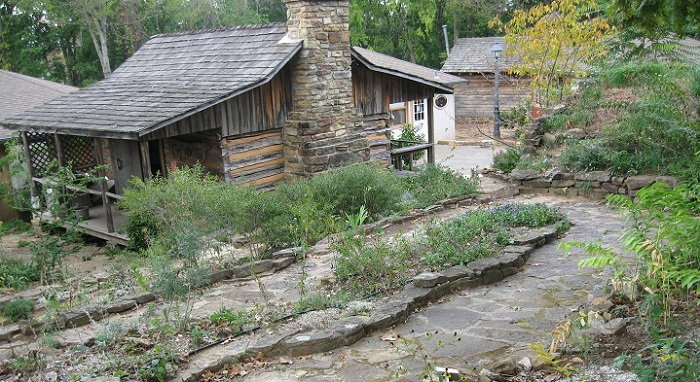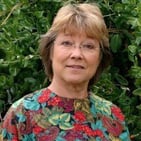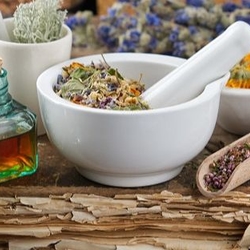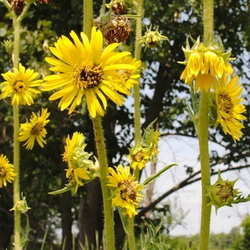Visions of her conjuring up some fantastic potion and the hilarious results, were the basis of much of the fun poked at the Hillbillies who "Loaded up the truck and moved to Beverly." In reality, herbal medicine was a necessary way of life for this very isolated and disadvantaged part of our country.
Doctors were scarce until just a few short years ago and many times the only medicine that was available came from the plants and trees found on the hillsides and in the valleys of these isolated communities.
When paved roads and conveniences finally came to the Arkansas Ozark area, herbal cures fell out of favor. The younger generation became accustomed to modern medicine and the “Old Timers” treatments were passed over for college educated “medical professionals.” Knowledge that had been inherited for hundreds of years was in danger of being lost forever.
In the 1970’s a group of people with a vision, led by country singer Jimmy Driftwood, decided that the old ways should be preserved in one location. The need for a vanishing way of life to have a place to exist and educate people ‘from off’, was essential to these insightful men and women. They went before Congress and pled their case to our government to help fund such an institution and the Ozark Folk Center was created. Music, crafts, gardens, and storytelling were the foundation upon which this cultural center in the town of Mountain View, Arkansas was built.
One of the focal points of the Folk Center is its extensive Herbal and Kitchen Gardens . The plants are all grown in natural settings and done so organically. Fresh herbs are used for seasoning at the restaurant on the grounds and herbal workshops are conducted during the year to better educate visitors.
As one wanders through the area, local volunteers will demonstrate various skills and crafts. Anything from harvesting herbs and proper drying techniques to fresh cookies baked in a wood burning stove can be observed. The gracious local volunteers are more than delighted to explain what they are doing and tell stories about the days passed. This is set to a backdrop of authentic mountain music playing in the air.

One of the most interesting parts of the herbal section of the Folk Center is the herb drying cabin. As the door opens into the diffused light, aromas of many plants waft through the dimness. Jars and bottles on shelves and drying plants hung from the open rafters, attest to the sole purpose of this little log structure.
It’s almost like stepping back into the 19th Century. There is no electricity or running water. The only modern convenience is the small glass-paned windows that let in a filtered light. It sits nestled under a little rock ridge that has a lovely waterfall keeping the moisture loving herbs happily growing along it’s edges. Visitors are encouraged to touch, feel, smell and taste their way around the gardens.
Tina Marie Wilcox is the Head Gardener and Herbalist in charge of the plantings at the Folk Center. She spoke about several of the plants and herbs that the mountain folk used in their everyday life. Many of these plants can sicken or kill those unfamiliar with their use and no remedy should be ingested without proper education and supervision. Also, there are many similar looking plants in the fields and forests. Some are quite deadly. Only someone trained in harvesting herbs should attempt to gather them and prepare the treatments.
One of the most common plants used by the Ozark Folk was the Willow Tree. Tea made from the inner bark was a fever reducer and pain reliever. This is actually a mainstream medicine today as the common aspirin is actually salicylic acid, originally derived from the Salix species, the Willow Tree.
Sassafras root was also used. Tea made from the roots were used as a blood purifier and spring tonic. This may have been fine for the Ozark folk, but Sassafras is dangerous when ingested in more than tiny amounts. A spoonful of the extract can kill a child. Safrole, found in the oil of the Sassafras has been banned by the FDA and has carcinogenic properties.
Black Walnut hulls were used for their anti-fungal properties. A common treatment for ringworm was a poultice made from the crushed outer hulls. The inner bark was chewed for toothache and made into tea which was a laxative. Black Walnut was also a popular substance used for dyeing fabric.
Poke Salet is a common plant with several uses. The young greens were cooked and eaten in the spring to promote general well-being. The berries were eaten in a prescribed number each year to ward off arthritis. Some accounts recommend only one berry per year, other accounts suggest a few more. Poke berry seeds are highly poisonous and should never be considered a treatment for arthritis though. Poultice made with the leaves were used to treat wounds, pimples and blackheads. The purple juice from the berries were also a natural dye used by many people.
Elderberry is used for many purposes. The leaves were used to treat wounds and stop bleeding. The berries were made into vinegar or wine and taken as a tonic. This was a treatment for colds and respiratory infections. The tonic also promoted sweating, which helped ’sweat out’ fevers or infections. In some countries, Elderberry is becoming an accepted treatment for colds and flu, as the flowers and fruit reduce fever and increase bronchial secretions.
Goldenseal was used as an antibacterial agent. The powdered root was used as an eye wash and a dressing for wounds. It is a popular herb today also. It was mistakenly identified as a substance that could mask illegal substances and produce a false negative in a drug test. This is absolutely not the case, but the Urban Legend persists with the unfortunate result that many of the wild plants being stripped from their woodland habitats. The wild population had diminished to the point that Goldenseal could now be considered endangered in some areas and is regulated by the CITES List.
Root Diggers are still active throughout the Ozarks and many of our wild herbs have been over harvested to a point that they are getting harder and harder to find. Our native Ginseng has been shipped to Asia for many decades now, and like the Goldenseal, its numbers are becoming fragile.

The Folk Center was created to educate and inform its visitors about the customs and practices of the mountain folk in times gone by. It also exists to serve as a bridge to our futures. By teaching people respect and understanding about the past, generations to come will appreciate the importance of preserving the collective knowledge contained there. Much research is now being done in the field of botanical medicinal potential. We have a whole pharmacy just waiting for us in the hills and forests, if we listen to the voices from our past.
Granny Clampett was one wise lady.
Special thanks to Tina Marie Wilcox, Kathleen Connole, Alma Lee Sutterfield, Hazel Cross,
and all of the gracious people in Mountain View, Arkansas for their knowledge, hospitality, and family stories.
Images courtesy of the Folk Center and myself


















